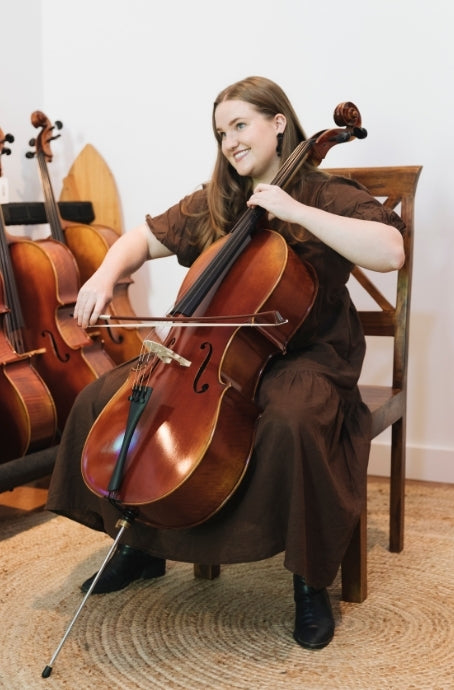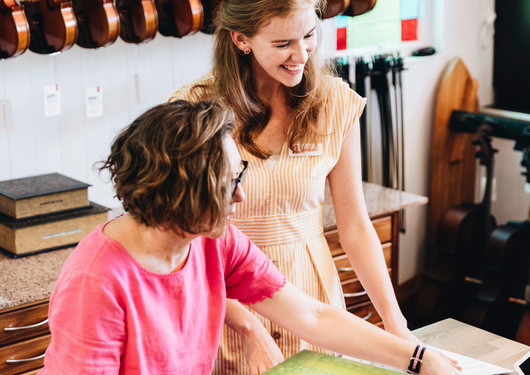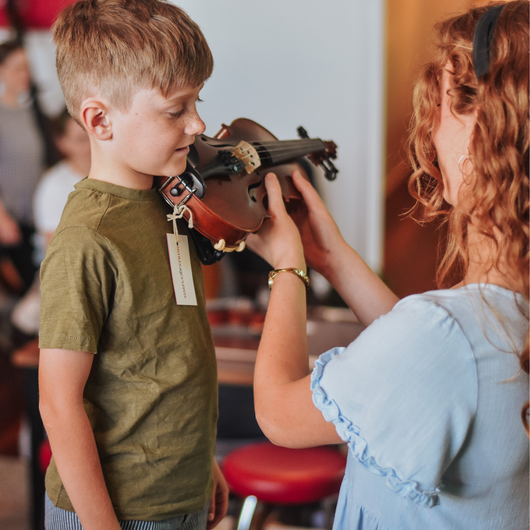String Instrument Sizing Guide
Measure in centimeters from the neck to the middle of the palm.

Directions for Measuring: With the player’s arm fully extended and parallel to the floor, measure in centimetres from the neck to the middle of the palm.
| SIZE OF VIOLIN | MEASUREMENT (CM) | AVERAGE AGE OF CHILD |
|---|---|---|
| 1/16 | 35 - 38 CM | 3 - 4 YRS |
| 1/10 | 39 - 42 CM | 4 - 5 YRS |
| 1/8 | 43 - 46 CM | 5 - 6 YRS |
| 1/4 | 47 - 51 CM | 6 -7 YRS |
| 1/2 | 52 - 56 CM | 7 - 8 YRS |
| 3/4 | 57 - 60 CM | 9 - 11 YRS |
| 4/4 | > 60 CM | 11 - 13+ YRS |
Directions for Measuring: With the player’s arm fully extended and parallel to the floor, measure in centimetres from the neck to the middle of the palm.
| SIZE OF VIOLA | MEASUREMENT (CM) |
|---|---|
| 12" | 53 - 55 CM |
| 13" | 55 - 59 CM |
| 14" | 59 - 63 CM |
| 15" | 63 - 65 CM |
| 15" 1/2 | 65 - 67 CM |
| 16" | >67 CM |
Directions for Measuring: Sizing cellos is slightly more complicated than sizing violins and violas. The student should be seated at the edge of a chair such that the knees are bent at a ninety-degree angle (feet flat on the floor). The upper edge (back of cello near where the neck joins the body) of the instrument should rest in the centre of the chest (on the sternum) and the C peg should be slightly behind the left ear. The knees should lightly grip the lower bouts ensuring that the corners do not dig into the side of legs. (Corners should be slightly above the inside of the knees). The student should be able to reach both ends of the fingerboard with ease. The chart below shows approximate sizing by age.
Note: 7/8 size cellos are available as well. This can be a useful transitional size or a more comfortable option for those players who prefer a slightly smaller instrument.
| SIZE OF CELLO | AGE OF CHILD |
|---|---|
| 1/10 | 4 - 5 YRS |
| 1/8 | 5 - 6 YRS |
| 1/4 | 6 - 8 YRS |
| 1/2 | 8 - 10 YRS |
| 3/4 | 10 - 12 YRS |
| 4/4 | 12 - 13+ YRS |
Directions for Measuring: The 3/4 size double bass is the standard size for adults. 7/8 size basses and 4/4 sizes basses are made but they are less commonly used.
As a rough guideline, when both the bass and the player are standing upright, the bridge should be approximately at the same height as the large knuckles of the student's right hand. The most important issue is that the instrument is comfortable and that the student can reach the higher registers of the fingerboard without difficulty.
The chart below shows approximate sizing by age.
| SIZE OF BASS | AGE OF CHILD |
|---|---|
| 1/16 | 3 - 4 YRS |
| 1/10 | 4 - 5 YRS |
| 1/8 | 5 - 7 YRS |
| 1/4 | 7 - 9 YRS |
| 1/2 | 9 - 13 YRS |
| 3/4 | 13+ YRS |






